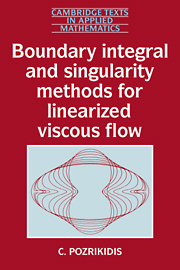6 - The boundary element method
Published online by Cambridge University Press: 13 February 2010
Summary
General procedures
Analytical solutions to the Fredholm integral equations that arise from boundary integral representations are feasible only for a limited number of boundary geometries and types of flow. To compute the solution under general conditions, we must resort to approximate methods. Reviewing the available strategies for solving the Fredholm integral equations of mathematical physics, we find a variety of approximate functional and numerical methods having varying degrees of accuracy and sophistication (Kantorovich & Krylov 1958, Chapter 2; Atkinson 1976, 1980, 1990; Baker, 1977, Delves & Mohamed 1985). In a popular class of methods, originated by Nyström (1930), we produce a numerical solution by carrying out the following steps.
In the first step, we trace the domain of the integral equation D with a network of marker points or nodes, and approximate D using a set of N boundary elements that are defined with respect to the nodes (see section 6.2).
In the second step, we approximate the unknown boundary velocity u, surface force f, or density of the hydrodynamic potential q over each boundary element using a truncated polynomial expansion in terms of properly defined surface variables. The set of all local expansions contains M unknown coefficients. When the unknown boundary function is assumed to be constant over each element, M is equal to the number of elements N; otherwise, M is greater than N. To facilitate the procedure, it is convenient to identify the coefficients of the expansion over an element with the values of the unknown function at the corresponding nodes.
Information
- Type
- Chapter
- Information
- Publisher: Cambridge University PressPrint publication year: 1992
